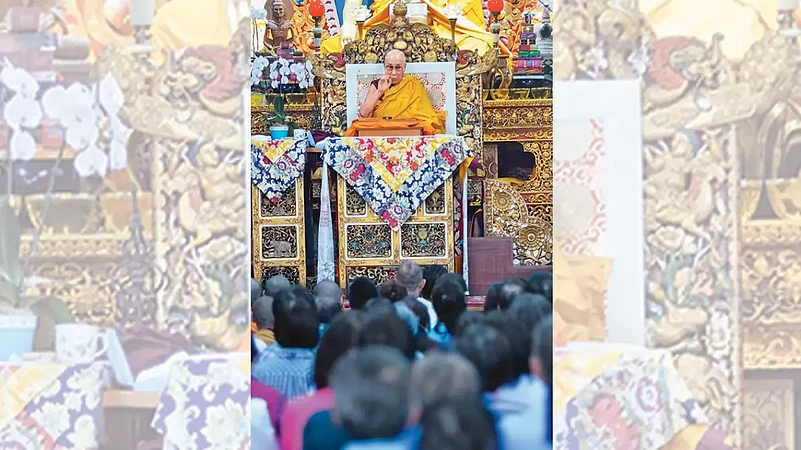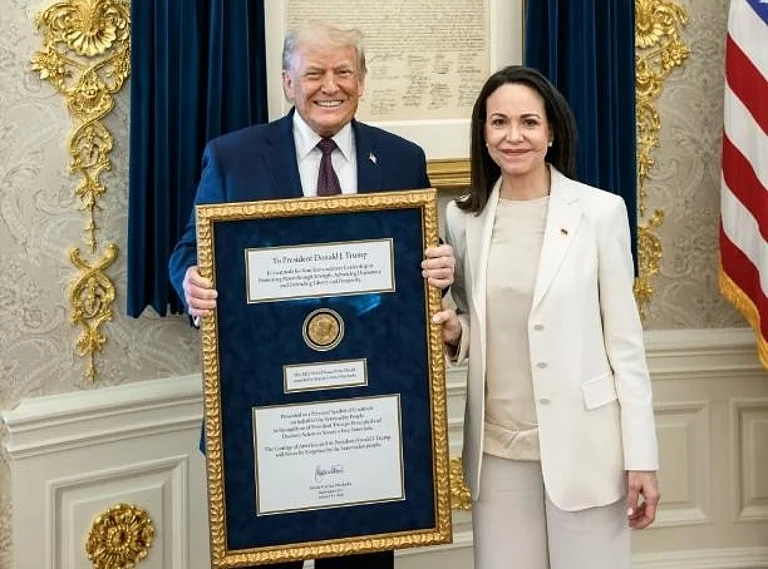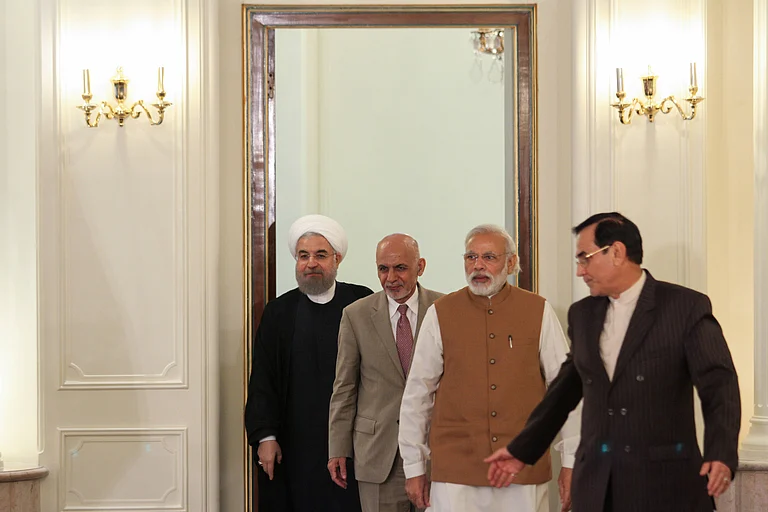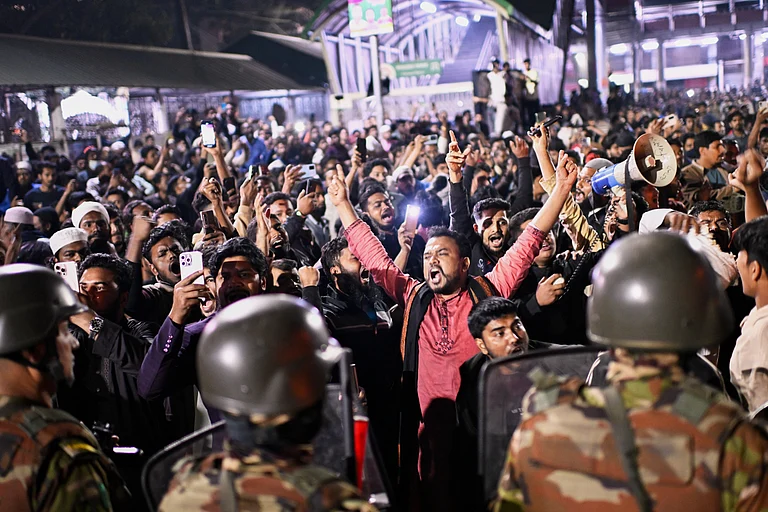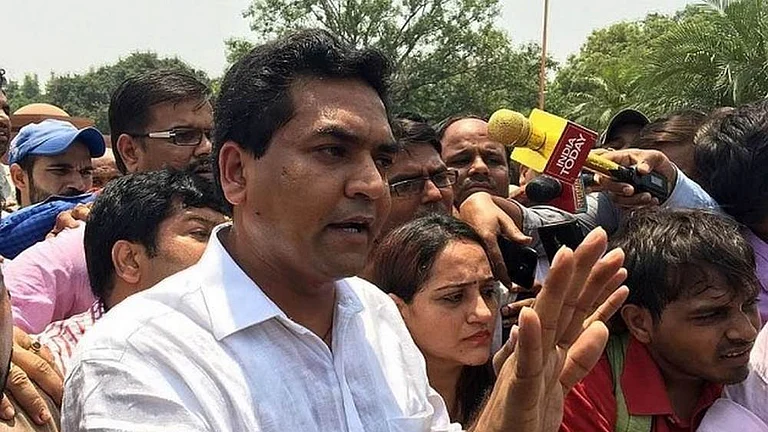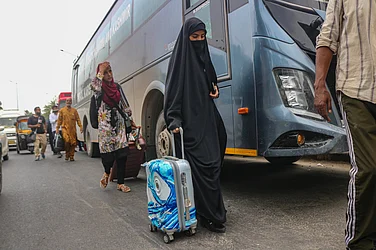Ten Phun, a young Tibetan poet, sells his poetry books barely 50 metres from the Dalai Lama Temple in Mcleodganj, a suburb in Dharamshala—home to Tibetan refugees. The Dhauladhar Himalayan range is clearly visible from where he stands, but as it’s an unusually humid day, he is carrying an umbrella.
Phun picks up a poetry book and reads out a few lines from his favourite poem that talks about the pain and suffering of Tibetan refugees and their desire to go back home. His mood changes a little, but when asked to comment on the recent Dalai Lama controversy, he is quick to dismiss it, and says: “It’s a Chinese doing.”
Just a few days back, hundreds of Tibetans, monks, nuns, youth activists and women hit the streets of Dharamshala seeking an apology from media outlets around the world for circulating a “distorted and doctored” video of the Dalai Lama, where is he seen saying to a boy, “suck my tongue”.
The incident happened at the Dalai Lama Temple—also known as Tsuglagkhang Complex—on February 28 when he had interacted with around 120 students. In the video, a boy is seen asking the Dalai Lama if he can hug him. The video shows the spiritual leader first asking the boy to kiss him on his cheek and lips. He is then heard telling the boy: “suck my tongue”. The video from the February 28 function resurfaced online on April 8-9 and went viral.
While people commented on social media platforms saying they found the video to be disturbing, the mood in Dharamshala and Mcleodganj is quite different. People—both, Tibetans and locals—are supporting the Dalai Lama. Among the 50-odd people whose views were sought for the story, not one voice condemned the spiritual leader.
Phun, for instance, believes that it was just a sweet moment between a “grandpa and a boy”. “He is a compassionate man. I have seen him many times being playful with kids. The boy’s mother was sitting right there,” he says.
The Dalai Lama’s office has issued an apology. The statement said he wanted to apologise to the child and his family “for the hurt his words may have caused”. It added: “His Holiness often teases people he meets in an innocent and playful way, even in public and before cameras. He regrets the incident.”
Later, the Dalai Lama stepped out for the first time to go to Delhi to attend the first-ever Global Buddhist Summit 2023 on April 20 and 21. When he came back, dozens of people lined up to seek his blessings. As his entourage moved under a tight Z-plus security, the spiritual leader obliged with an affectionate smile. His car moved into the campus and the gates were closed soon after. He, like always, has been meeting with delegations inside the complex ever since.
It’s business as usual on the streets of Mcleodganj, too. The streets are packed with tourists from India and across the globe and the marketplaces are buzzing with activities. On one of the streets, Tsering Dolma is selling handicrafts. He feels people in Dharamshala are blessed. “Till the time the Dalai Lama is here, we have nothing to worry about. He will live for more than 100 years and will always be in our prayers. The Indian government is also taking good care of him. It’s all good,” he says.
Sonam Tsering, the general secretary of the Tibetan Youth Congress (TYC)—a non-government organisation having 89 chapters across the globe—says the organisation has “zero tolerance” towards anyone who tries to tarnish the image of the Dalai Lama. This is significant because the organisation has ideological differences with the spiritual leader over his approach towards the free-Tibet movement.
The Central Tibetan Administration (CTA) advocates the middle path approach, where Tibet remains a part of China and Tibetans have true autonomy, but the TYC continues to call for complete independence. But on the recent controversy, both are on the same page. Tsering says he feels sad that some newspapers and social media handles “continue to play into the Chinese hands.”
“We know the Chinese have been ruthlessly restoring to misinformation and propaganda against the Dalai Lama. But this time it was an assault on his character, which we will never accept. That’s why the Tibetans and the Buddhist community in the entire Himalayan region are angry. The protests will continue,” he says.
The incident has united the Tibetans, says Tenzin Lekshay, the spokesperson of the CTA. While talking about the situation in Tibet, he says Tibetans have no access to photos or videos of the Dalai Lama. They can’t even carry his photo in their pockets. But now Tibetans are writing emotional posts on the social media about the controversial video being available on Chinese sites.
He talks about a Tibetan secondary school teacher who wrote a post about the Dalai Lama but was detained and has been missing since April 10. This is what the post said: “It’s a blessing to be able to watch him online albeit in a distorted way. This is an auspicious sign that His Holiness will return to Tibet soon. We teachers and students alike, must pray wholeheartedly as this opportunity to watch him online is as auspicious as meeting him personally.”
Some are also questioning the timing of the video. A Tibetan journalist reporting for a foreign TV channel says on the condition of anonymity that the Chinese knew that Prime Minister Narendra Modi and the Dalai Lama would be present at the Global Buddhist Summit in Delhi. China probably wanted to create controversy ahead of the summit as it was not invited, he feels.
Some like Tenzin Dharpo, the editor of Phayul.com, a Tibetan web portal, are defending the video. “In Tibet, sticking out your tongue has been a traditional way of saying hello. It is also a sign of respect. It has also been used as a greeting in Tibetan culture. The clip is definitely taken out of context and the Chinese are waging a character assassination campaign.”
Dharpo’s wife, Tenzin Choezin, a member of the 17th Tibetan Parliament-in-Exile from the Utsang province, says the current controversy has hurt the sentiments of Tibetans. The Tibetan Government-in-exile and the Parliament have already condemned it. “The episode is completely a sensationalist move, clickbait. The followers of His Holiness are deeply disturbed and stand with the Dalai Lama,” she says.
While Dharpo was born in Ladakh after his parents escaped from Tibet, Choezin was born in Dharamshala. Both have never been to Tibet, their homeland, but wish for a free and independent Tibet.
Dharamshala has been home for the Dalai Lama ever since his escaped from Tibet in March 1959 at age of 23 fearing he could be arrested by the Chinese. Some years ago, there were tension between the Tibetans and the locals, and it was speculated that he may move out of Dharamshala, but he put the controversy to rest.
In November 2021, while interacting with foreign journalists from Japan, the Dalai Lama said: “I have lived here in Dharamsala for several decades now. I enjoy it. I can communicate with everyone from here wherever they are. I’m free. Some years ago, I told former Prime Minister Manmohan Singh that I’d like to remain here for the rest of my life because here I have complete freedom.”
(Edited by Swati Subhedar)






